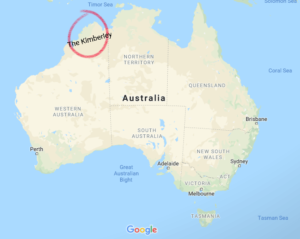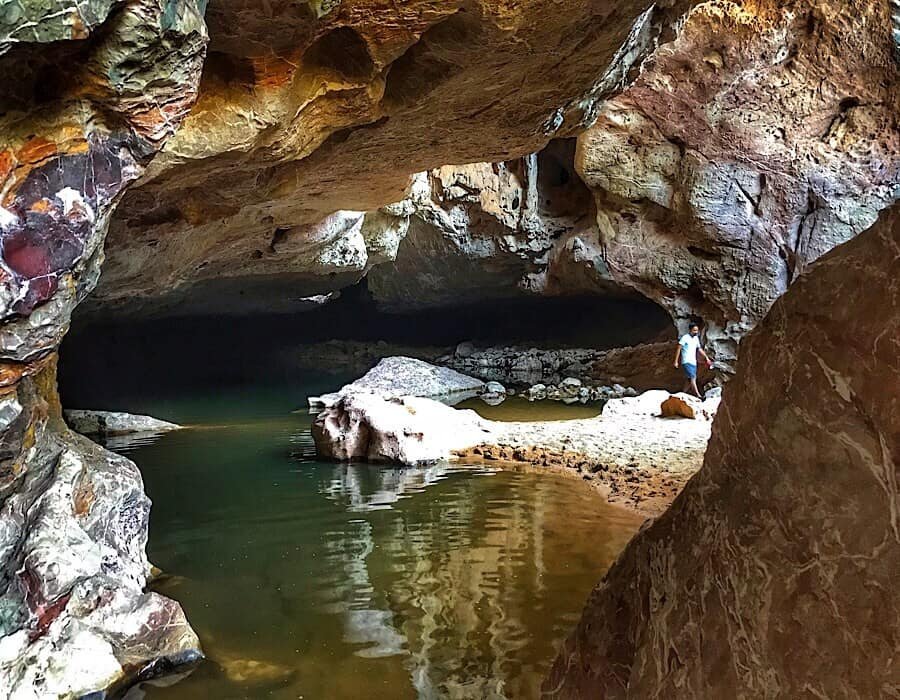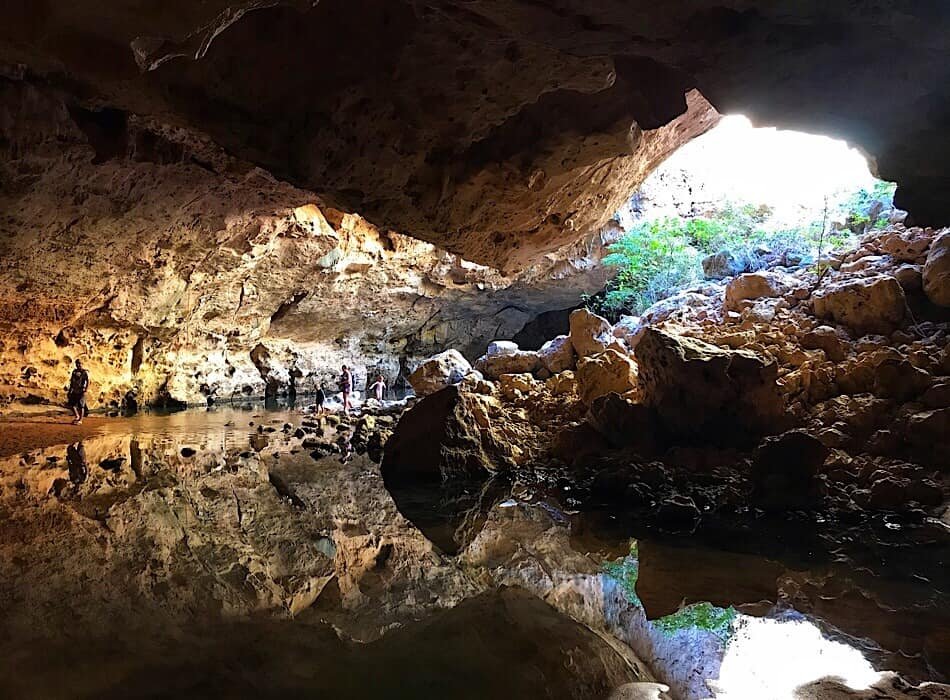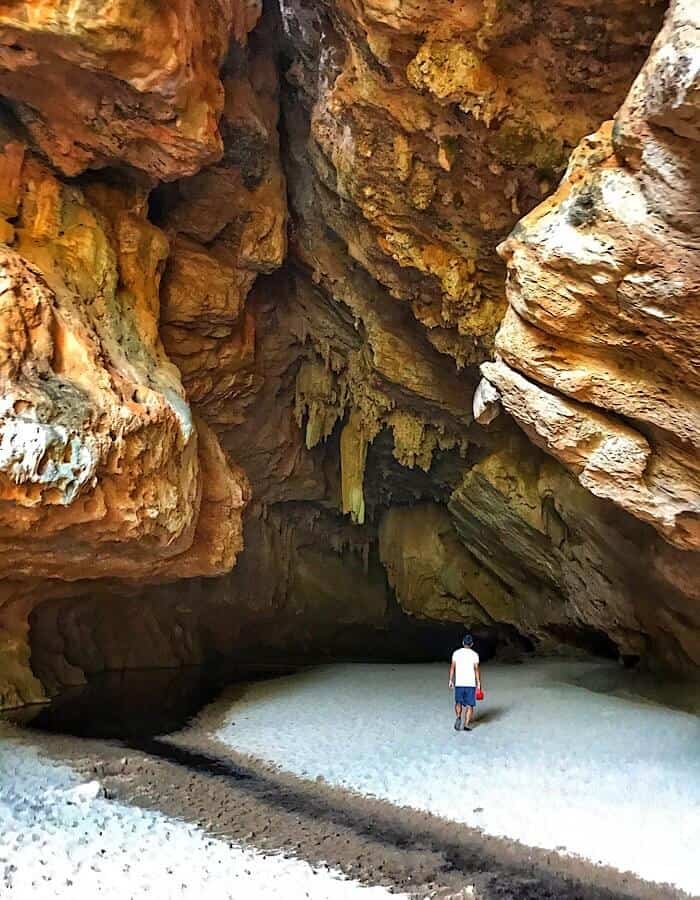“There’s a baby croc over there,” said the lady sitting on a rock in the opening of the cave. She pointed to the far wall of the cave. I looked over and saw the slender, motionless body of a baby crocodile resting just below the surface of the water, his nose and eyes protruding above the waterline.
We were standing in the mouth of Tunnel Creek. It is a cave under a large limestone wall that are the remains of the Devonian reef system. This tunnel allows passage of the creek under the mountain. During the dry season, the water slows to that of a small brook but leaves behind large pools in the deepest sections of the cave.
On the other side of the mountain the cave opens again to an area of sacred significance to the Aboriginal people. Cliff art can be found on the far entrance.
We proceeded forward and the cave grew pitch black. Deep in the cave, we came to a pool of murky water that stretched from one side of the cave to the other its depth unknown. The water had to be crossed to reach the other side. We stood there wondering what might be lurking in those waters.

Derby
Tunnel Creek lies 56 km off the Gibb River Road. The closest town is Derby almost 200 km away at the west entrance of the Gibb River Road.


Derby is a great stop to refuel and stock up on groceries. I was impressed by the visitor center in Derby. We continually stop at all the visitor centers along the way. Many of them are only sales offices for local businesses. So far my favorite visitor centers in Australia are the one in Lithgow, NSW and here in Derby, WA.
In both Lithgow and Derby, the staff in the visitors center were excited about their region, had local knowledge and important information like road conditions and suggestions on places to go and places to avoid.
After gathering information on road conditions and stocking up on supplies we started down the Gibb River Road.

Gibb River Road
The Gibb River Road is an adventurer’s route through the Kimberley. Both the Kimberley and the Gibb River road are often spoken of with wonder and reverence. Just like the Nullabor, it’s a road to a region that is truly an Australian experience.
Most of sites off the Gibb River Road are currently closed (July 2020) as they are within remote indigenous communities. These communities are restricted due to COVID.
A large part of Gibb River Road is inaccessible to a bus like Lil’ Beaut anyway. A very hefty 4WD is needed along with experiences on true 4WD tracks. Even if we could make it down the road our air intake is too low and we would stall out on the river crossings.
We were excited to at least experience the first small section of the road. Half of the way to Tunnel creek is paved. Then the road turns to red dirt, the further we got the more corrugated the road became. When we turned into the road toward Windjana the road surface became rocky so we lowered the tire pressure on Lil’ Beaut and proceeded slowly.

Tunnel Creek
After parking in the dusty lot for Tunnel Creek, we donned our water shoes and grabbed two flashlights. We walked towards the wall of stone that rises from the flat plane. It is a long limestone reef that seems to rise on its own in the middle of a vast plain.
As we neared the wall the trail began to wind between large rocks leading directly to the cliff wall. The mouth of the cave was not yet in sight, but I could feel cold air being breathed out of a cavern. A short rock scramble later and we were in the wide opening where the creek snakes below the mountain.
A family sat on some boulders waiting for news from other cavers before they proceeded. It was here that the baby crocodile was pointed out to us.
“Aww, he is so cute,” I said.
“I wonder where momma is,” Trin said.
Just then a few lights from the darkness appeared. The headlamps grew more distinct and two men stepped into the light that filtered into the opening.
“We only made it a little past the halfway point. After that you have to swim to get further into the cave,” they informed us.

Wading into dark murky waters where crocs rest
I had hoped to make it through the entire cave and see the ancient paintings by aboriginal people on the other side.
The crocs were a bit concerning. Signage at the start of the hike warned that crocodiles like to hang out in the cave but that they are generally not a threat unless disturbed.
We waded through the shallow water where we could clearly see through the water to the sand and rock below. Then we followed a sandy path along the edge of the cave. Soon the darkness surrounded us completely and we turned on our flashlights.
Before long we came to a water crossing where the bottom was not visible. The large pool in front of us stretched from one side of the cave to the other. There was no way around it. The water was murky and the flashlights did not penetrate beyond the first inch of water. We had no idea how deep the pool would get between here and the opposite side.
Trin started across one careful step at a time. I followed directly behind. I wondered, does accidentally stepping on a crocodile in the water constitute “disturbing” them?
The water was thigh deep and then thankfully started to grow shallow again. After navigating another half a kilometer we reached the center of the tunnel.
Part of the roof of the cave has collapsed in the center letting light through and casting shadows around the stalactites.

Slightly Terrifying
After taking pictures in the center of the cave we proceeded down the dark passageway. We reached the large body of water where the other hikers stopped. We carefully maneuvered our way along a ledge on the right side till it ended. The water below us looked deep, but there was really only one way to find out for sure. We would need to lower ourselves into the water. It was pitch black except for our weak flashlights.
I carefully slid down the muddy side into murky water hoping I would feel the bottom soon. The water was almost to my waist by the time my feet reached the sandy bottom. We cautiously stepped forward and the water deepened.
“This is slightly terrifying,” I deadpanned to Trin.
We kept waking forward. The water now halfway up my stomach.
“I think I saw some eyes just above the surface over there,” he said pointing his flashlight to our right. The reflection was no longer there. Did the crocodile go back under? Was it just the trick of our imagination?
With the next few steps, the water seemed to grow shallow again. Reaching the other side we climbed out relieved to be out of the water.
One more deep water crossing and then we began to see light from the other end of the cave. We walked out excited to have traversed the entire cave.

The context of fear
There was probably very little danger of us being bitten by a croc, but they are not an animal I grew up with. Black bear I’m used to. A sign on a trail warning of black bear does not give me pause. I just make more noise and continue on. We have had multiple encounters with them and I’ve even smelled their rancid breath, but having grown up with them they just don’t seem scary.
Maybe it is the same with the freshies (freshwater crocodiles) to the locals. It’s really no big deal, but it was a new experience for us.
Before entering the Amazon jungle I never dreamed of swimming in waters filled with piranha and all manner of fish with massive teeth, caiman, and anacondas. Yet once there deep in the jungle, an afternoon dip in the Amazon river seemed normal, natural even and refreshing. If so many of the locals do it, surely it’s fine, the locals know more about it than me. They are not afraid so why am I?
Sometimes fear of the unknown can be reduced by those whom we surround ourselves with. I knew that Australians loved this cave and I never heard any of them talk about scary freshies, so I told myself we would be fine.
At the end of the cave after taking pictures of the paintings by Aboriginal people we turned around and headed back through the tunnel towards Lil’ Beaut. The way back was not at all scary. Like many fears, once faced they lose their strength.

Windjana Gorge
After completing the hike through Tunnel Creek we drove back the way we came and stopped at the Windjana Gorge.
Caution signs warned us of crocodiles along the bank. I was excited to see some, without the risk of unknowingly stepping on one in the water.

We saw two small crocodiles resting on the trail beside the water. I took a few pictures and we walked well around them so as not to disturb them. I respect the fact that they are fast and can give a nasty bite.
It was late in the day and the sun was getting ready to kiss the horizon and release its colorful hues. Pastels reflected off the canyon walls and the smooth surface of the water. Here and there the smooth surface was interrupted by the backs of crocodiles lazily floating in the river. We counted 15 of them just in this small section.
A little further along the trail, we found four crocs lounging on the river bank. One of them had his long narrow snout resting on the larger crock beside it. It was so sweet.

Camping in the bush
Generally, we try to always make camp before the sun sets to avoid hitting animals on the road, tonight would be an exception. We still needed to make it back up to Gibb River Road where we planned to park off the road at a secluded spot where free camping was allowed.
Wallabies hopped along the road, many of them crossing just in front of us. We drove slowly both because of the condition of the road and the wildlife hopping all over. We made it to camp and rested peacefully in the quiet of the outback. In the morning wallabies grazed around Lil’ Beaut.
Find your blue door – tackle your fear, try something new, just one small step to reduce the strength of the fear. It is called systematic desensitization.



Beautiful Bonnie. My fear is not of the crocodiles but of those corrugated dirt roads.
They are rough! ?
I’d be more worried the rest of the roof might decide to fall on me!
That’s a good point too!
Enjoyed reading your descriptive text. Thank you.